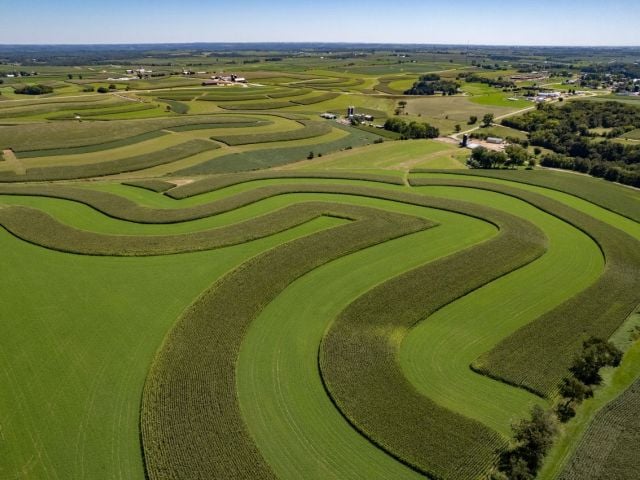
From coast to coast, almost 29,000 people in the 50 largest U.S. cities had received a combined $555 million in farm subsidies as of 2021, as the payments soared during the Trump administration.
The surge in Department of Agriculture farm subsidy recipients in these cities was mostly due to payouts from two Trump-era disaster programs – the Market Facilitation Program and the Coronavirus Food Assistance Program, an Environmental Working Group Analysis finds.
In Chicago, Los Angeles, New York and other major cities, between 1995 and 2021, exactly 28,831 people got subsidies totaling just under $555 million. That’s a significant increase over the number of recipients and value of subsidies just a few years ago.
In 2018, an EWG analysis identified 19,832 “city slickers” – urban dwellers – in the nation’s largest cities who had received $109 million in farm subsidies as of 2017. Those figures also represented an increase over previous years – EWG found that 17,836 people living in the 50 biggest U.S. cities got $63 million in farm subsidies in 2015 and 2016.
The size of payments to city slickers and the amount of recipients has increased significantly in the years since 2017. Since then, the average payment has increased, from just over $3,000 going to just over 16,000 people, up to its highest in 2020, when average payments reached nearly $22,000 going to more than 20,000 people.
Farm subsidy recipients must be “actively engaged” in farming. But under current law, urban residents can and do get farm subsidies even if they do not live or work on a farm.
The Government Accountability Office in 2018 found that roughly one-fourth of farm subsidy recipients do not contribute personal labor to farms.
By contrast, anti-hunger assistance programs are subject to much stricter income and asset tests, so people living on low income stay eligible for Supplemental Nutrition Assistance Program benefits for only 12 months, on average.
Rather than closing loopholes that allow city slickers to receive farm subsidies, the 2018 Farm Bill created new subsidy loopholes by allowing a farmer’s cousins, nieces and nephews to receive payments, whether they live or work on a farm or not.
Table: Farm subsidies rose during Trump administration for people in 50 largest U.S. cities
| City | Recipients | Total |
|---|---|---|
| Albuquerque, N.M. | 468 | $5,771,058.69 |
| Arlington, Texas | 429 | $3,640,827.72 |
| Atlanta | 351 | $3,147,202.18 |
| Austin, Texas | 1,287 | $15,537,323.24 |
| Bakersfield, Calif. | 474 | $61,044,895.85 |
| Baltimore, Md. | 43 | $1,000,288.84 |
| Boston | 25 | $837,805.07 |
| Charlotte, N.C. | 210 | $2,621,918.84 |
| Chicago | 526 | $6,324,579.32 |
| Colorado Springs, Colo. | 589 | $6,582,394.43 |
| Columbus, Ohio | 321 | $4,411,185.39 |
| Dallas | 1,318 | $17,172,774.93 |
| Denver | 975 | $10,657,980.86 |
| Detroit | 40 | $290,485.73 |
| El Paso, Texas | 209 | $5,984,905.26 |
| Fort Worth, Texas | 865 | $17,215,142.34 |
| Fresno, Calif. | 1,266 | $97,680,950.65 |
| Houston | 1,992 | $21,181,654.30 |
| Indianapolis | 731 | $9,109,378.78 |
| Jacksonville, Fla. | 202 | $1,883,606.30 |
| Kansas City, Mo. | 1,337 | $14,189,115.33 |
| Las Vegas | 253 | $4,350,693.56 |
| Long Beach, Calif. | 76 | $1,703,985.70 |
| Los Angeles | 223 | $9,490,534.54 |
| Louisville, Ky. | 467 | $3,736,138.60 |
| Memphis, Tenn. | 999 | $14,482,809.39 |
| Mesa, Ariz. | 321 | $8,240,067.71 |
| Miami | 403 | $25,711,196.50 |
| Milwaukee | 114 | $1,236,818.69 |
| Minneapolis | 720 | $10,908,305.55 |
| Nashville, Tenn. | 440 | $3,732,030.10 |
| New York | 191 | $2,733,103.60 |
| Oakland, Calif. | 81 | $770,859.82 |
| Oklahoma City | 1,267 | $13,826,522.53 |
| Omaha, Neb. | 1,602 | $26,807,446.88 |
| Philadelphia | 39 | $922,061.15 |
| Phoenix | 436 | $13,268,156.76 |
| Portland, Ore. | 450 | $5,127,831.47 |
| Raleigh, N.C. | 249 | $3,813,354.85 |
| Sacramento, Calif. | 227 | $7,490,124.81 |
| San Antonio | 1,078 | $16,900,412.28 |
| San Diego | 315 | $3,494,921.68 |
| San Francisco | 202 | $3,498,127.90 |
| San Jose, Calif. | 192 | $5,321,126.13 |
| Seattle | 465 | $5,014,325.01 |
| Tucson, Ariz. | 430 | $6,565,064.45 |
| Tulsa, Okla. | 719 | $9,312,075.32 |
| Virginia Beach, Va. | 173 | $4,043,436.94 |
| Washington, D.C. | 165 | $2,141,955.14 |
| Wichita, Kan. | 2,876 | $34,052,859.60 |
| Total | 28,831 | $554,981,820.71 |



